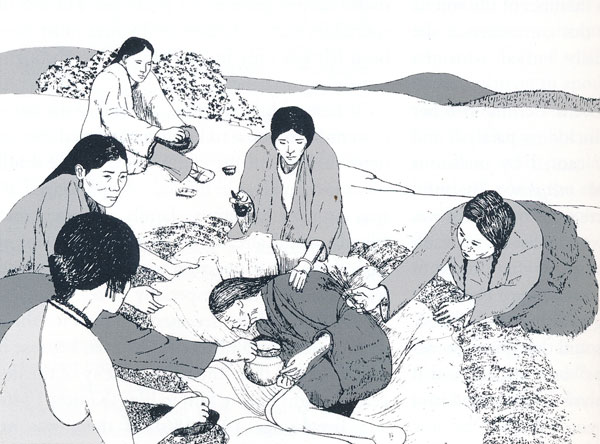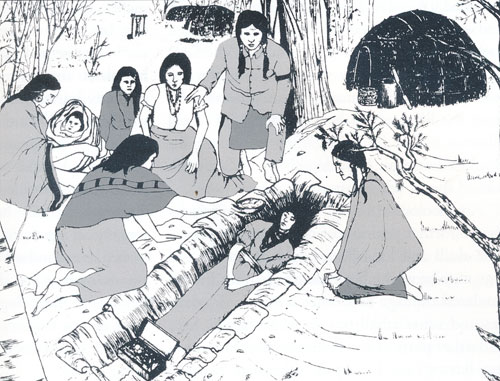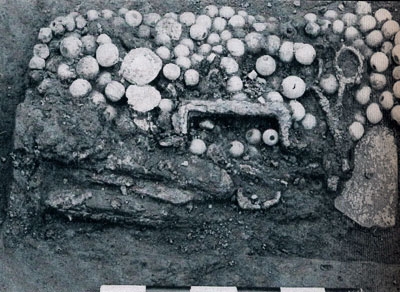This site was founded by the late John Skakel. Contact us HERE
Cemeteries Office Staff have asked that users NOT contact them with questions directly.
Chatham-Kent's First Inhabitants
Please note that this page is for general interest and NOT for reearch.
Please See Information below on early Native Internment Customs

Common Type of Native Burial in Earlier Times
From "The Lenape-Delaware Indian Heritage"
By Herbert C Kraft.
Please Click the photograph above for Early First Nation Interments in Chatham-Kent
Proceed to our "European Cemeteries Area"
Click the photograph above for Early First Nation Interments in Chatham-Kent
To see information on Christian First Nations in Chatham Kent, see our Other Cemeteries Documention area of our web site.
About 10 - 11 thousand years ago our First Peoples began to arrive in Chatham-Kent and although we of European origin often forget such, our Native Brothers and Sisters have lived here pretty much continually ever since. We do not know of course exactly when they first arrived, nor do we know what route they took, or where their first settlements were, although people educated in these areas of our history can begin to try to put some of those pieces together now.

Common Type of Native Burial after European Contact
From "The Lenape-Delaware Indian Heritage"
By Herbert C Kraft.
There have been many different burial traditions over those thousands of years. Some, like those of the Deleware Nation at both Old and New Fairfield are quite recent, and thus we have records of them. Some are known by local farmers and no one else. Some are known by historians. And many are just simply lost. For instance, historians have uncovered information that there was a large native village exactly on the site where Chatham's OLD Maple Leaf and OLD St Anthony's cemeteries join today along that creek, and it is known that two different native burial sites with only a few burials have been found in close proximity to it. It is rumoured that The bones from one site were said to be dug up long ago and sold. However, with villages this large there must have been at least one larger burial area, and has never to this day been found. May they all rest in peace in their earthly graves.
Plows have uncovered some of these very old graves over time in Chatham-Kent, and a very few tiny fragments of broken Human remains can be seen even today. One located not far from me today was called the Julian Mound. However, it's position should not be documented here although it was known to be excavated long ago. Copper beads still existed today from it not long ago in a local collection.
There is one thing that we who are not historians do not understand though. Bones do deteriorate over time. However, if a body is cremated, it leaves a layer of inert carbon on those bones, and thus they last hundreds of years longer. History books record incident after incident of bones of our cremated human ancestosrs from the very old times with few non cremated ones being found. This does not mean that all early natives were cremated. It simply means that if they were not cremated their skeletal remains have returned to dust in most all cases.
There are many different phases of native occupation in Chatham Kent. Please note that even the following numbers very in different books. Not all researchers use the same years for periods. Among these are Paleo-Indian Pathfinders who lived about 12,000 to 10,000 years ago. Archaic Hunters, Fisthers, and Gatherers who lived about 10,000 to 3,000 years ago. Early and Middle Woodland Periods who lived about 3,000 to 1,000 years ago. And then, late Woodland who lived about 1,000 to 400 years ago. Then came the periods of Early European Contact, and European Civilization and finally the forced movements of the Natives to the West.

Jewelry box from woman's grave in New Jersey.
Note the Drawing above and to the right
showing a Jewelry Box at foot of the woman's grave.
Note handle, white wire wound glass beads, scissors,
and mirror, runtees, and bone handled clasp knife.
From The Lenape-Delaware Indian Heritage
By Herbert C. Kraft.
To document early Native History we almost must look at it at a North American scale and then relate that to our own area.
Paleo Period. 10,000 - 8,000 years ago
The early Natives would migrate long distances to find food. They were really the Nomadic Hunters. Burials were possibly often done nearer to where the death occurred before the people moved on to find more food. Little seems to be known of the burials in this time period. We can only surmise that they would be rather "Spread out over the lands as the peoples moved".
Archaic Period. 8,000 - 2,000 years ago
The people are now beginning to get food more locally, and migrate much shorter distances. Some burials noted in extended position on the back. Often Burials were quite simple, but in other cases the dead may have been given preferential treatment according to their social status. Many were attired in their finest garments and were accompanied by grave offerings of bone combs, bird bone flutes, turtle shell rattles, perforated bear and elk teeth, and other decorative objects made from bone and antler and shell. Dogs were sometimes placed into these graves to accompany the deceased.
In other places deceased were cremated and the residual bones were collected and placed in special ossuaries together with spear points, knives, spearthrower weights, sharpening stones, and gouges. In one area in New Jersey (2050 - 1620 BC) 52 burials in 39 graves were found within an area only 40 by 70 feet. Deceased were cremated elsewhere. Some were burned after death and others allowed to decay before cremation. 16% under 15 years of age, but probably the bones of many infants were totally consumed and thus not counted. East to West in irregular rows. Cremations MAY have been mostly in the winter, with spring, summer, and fall being direct burials. Bundle burials have also been found in areas that are between 4,000 and 8,000 years of age. We need to remember that there were different Native People's all across North American and their customs varied according to their needs.
Early and Middle Woodland. 3,000 to 1,000 years ago
Now, the Native Peoples were becoming the real native farmers that we know think of today as being the Native Culture. They would move into an area and build villages and farm the farms. Then when the land became less fertile from this type of cultivation and "Farmed out", they would then maybe move on a short distance.
The following are only two of the many cultures.
Orient Culture 1200 - 1600 BC.
Some times, possibly 30 - 60 stone pots in burials. Oval, rectangular, or nearly circular or trough shaped 6 to 18 inches in length. Most soapstone pots were broken in ritualistic manner. Some pots were partially embedded in red ochre in a manner suggesting that sherds were deliberately inserted so that only the rim portion extended above the red pigment. Breaking an artifact in a ritualistic manner was thought to release the spirit of that object and enabled it to accompany the spirit of the deceased to the land of the dead. Burial pits included Fishtail points, perforators, gorgets, pestles, and fire making kits.
Some recorded burials were in pits 33 to 96 inches deep. On Long Island communal pits were found with small numbers of individual ones. Most at high elevations and some distance from habitation sites. Large amounts of red ocher here. Red colour may represent blood.
Meadowwood Culture. 1250 - 500 BC.
Habitation sites were generally on flat terrain that provided good fishing. The Lenape Natives may have lived in dome shaped houses with doors at each end. Often they were traders. Soapstone pots were often used for cooking, and baking done as well. Fires were started with highly valued fire kits.
At this time the Atlatl was still used to launch spears but seems to be becoming less frequent. Bird stones were frequent. MAY have been used on the heads of women. Dugout canoes were used.
Deceased kept in charnel houses until all or most of flesh decayed. Then burned on pyre, sometimes wrapped in leather burial shrouds. GEnerally bones burned were fresh and not dried.
Graves had burned food like dog, deer, bird, fish and plants. Tools almost never burned included some of mortuary blades made for the occasion, and broken grave goods like implements, worn out objects, and long treasured heirlooms, fire making kits and sometimes Adena points. Red ochre spread over all.
Middle Woodland burials included many various burial postures included extended, loosely flexed, tightly flexed, bundle, re-deposited cremations, and in situ cremations.
Before and after European Contact
As soon as Europeans came these people had no resistance to their diseases. They had not used animals to a great degree and that affected their disease resistance levels. First Nations peoples were killed by diseases in unbelievable numbers.
Burials at this time though would just gradually become more "linked" to the "White European" customs with the oncoming of the Christian Missionaries. The Old Native Burial Customs and Ceremonies were coming to a close as the European customs were in fact beginning to change as well. The old native villages gave way to more European based farming methods. Changes had come.
Exploring the Culture
Please note once again, that we can only do limited research on this history here. This page should be read for general interest and NOT be used for research or documentation.
If you ever get the chance to talk to a native historian about their history, or to look at a native burial area along with a native person please make certain that you take the time to go and listen to them. You must of course be very respectful while listening to them. The old beliefs of Native people state that the spirits of the dead live on through those bones, and thus you must enter a burial area with respect and reverence. But if you can go with a native Father or Historian, you will not soon forget those few moments. It will be the experience of a life time. Some time take the time to sit down with one of their Historians for a couple of hours and just let them talk to you. You will be SO glad that you did. I promise!
Proceed to early First Nation Interments
Proceed to our "Non Native Cemeteries Area"